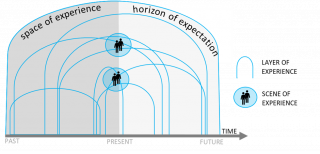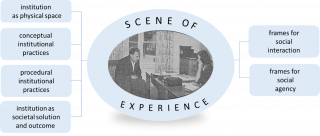Minna Harjula and Heikki Kokko, Tampere University
https://doi.org/10.58077/SSXN-4N37
The ‘scene of experience’ is a tool for analysing situations in which experiences emerge at specific moments of time, space and place. We have developed the concept, which has been used in various academic disciplines with diverse meanings,[1] for use in the social history of experiences. As the ‘scene’, combined with the temporal ‘layer of experience’, is a component in our broader social and historical theorization of how social reality is constructed through experiences, it contributes to both the methodology and the theory of the social history of experiences.[2]
We developed our ideas for the ‘scene’ from Reinhart Koselleck’s temporal conceptualizations of ‘space of experience’ and ‘horizon of experience’ in the framework of Peter L. Berger and Thomas Luckmann’s social constructionism.[3] The circulation of knowledge, theorized within the history of knowledge, is our third source of inspiration.[4] We anchor these starting points – all of which emphasize the social and mediated character of experiences as the meaning-making and construction of reality – to the structural history of society.[5]
In this approach, the scene of experience is the situational moment in which experiences emerge in social interaction (see Figure 1). Analytically, the scene of experience is the concrete situational occasion that links the space of experience and the horizon of expectation. While the Koselleckian terms conceptualize possible experiences and future horizons available in the present, the scene concentrates historical focus on the concrete situational occasions where the tension between experiences and expectation is lived and the active ‘framing’ of social reality takes place.[6]

In the scene, social structures meet the moment of experience. The scene crystallizes the temporal layers of experience that – as circulated and legitimated everyday experiential knowledge – have been institutionalized as the structures of society. It also brings out the moments of time, space and place where new societal layers take shape as a result of the tension between experiences and future expectations. Besides affording a means of analysing everyday life, the scene enables a ‘from below’ view on social change by turning the focus to the specific moment and space when social change is experienced.
The scene of experience combines the socio-material environment and the interrelated sociocultural ‘preconditions’ – age, social class, education and gender, among others – that structure and frame social interaction and agency by creating ‘conditions of different chances for experience’.[7] The earlier layers of experiences have institutionalized in the socio-material environment as practices, concepts and buildings, among other things. Besides the shared frameworks for experiencing adopted in socialization, the sociocultural preconditions shape different ‘contexts of possibilities’[8] for experience and for social agency in the scene.
Figure 2 presents one example of how the scene was operationalized in analysing the lived welfare state as encounters between citizens and officials in various welfare-state institutions.[9] The approach nuances macro interpretations of welfare-state development by indicating the conflicting layers of individual-society relationship that were simultaneously present in the institutional encounters and that survived in institutional practices despite new legislation.

The analysis of scenes can be extended from concrete places and encounters to situations that reach beyond face-to-face interaction. For example, the situations where people participated in the nationwide culture of letters to the press in nineteenth-century Finland could be understood as a new scene of experience (see Figure 3). The interactive reading and writing of the letters broadened the conception of ‘local’ and enabled the emergence of a new ‘translocal’ layer of experience of social and national belonging.[10]

For the social history of experiences, the combination of ‘scene’ and ‘layer’ opens a situational from-below view that links the micro-level social processes of experience to the macro structures of society. By focusing on the situational social interaction and on the contextual frames that set limits for the possible experience, the scene anchors the analysis of experiences to the history of society.
Notes
[1] The concept ‘scene of experience’ has been used in language, poetry and film studies and design, for example: Jan Firbas, ‘Scene and Perspective’, Brno studies in English, 14 (1981): 37–79; Michael G. Kelly, Strands of utopia: Spaces of poetic work in twentieth-century France. (New York: Modern Humanities Research Association & Routledge, 2008); Sam B. Girgus, Levinas and the Cinema of Redemption: Time, Ethics, and the Feminine. (New York: Columbia University Press, 2010); Vesa Jääskö, Tuuli Mattelmäki and Satu Ylirisku, ‘The scene of experiences’, The Good, the Bad and the Irrelevant, eds Leslie Haddon et al. (Helsinki: Media Lab UIAH, 2003). Similar recent conceptualizations, the ‘emotional arena’ and the ‘arena of knowledge’ have enriched the fields of the history of emotions and the history of knowledge. Mark Seymour, Emotional Arenas: Life, Love, and Death in 1870s Italy (Oxford: Oxford University Press, 2020); Mark Seymour, ‘Emotional Arenas: From Provincial Circus to National Courtroom in Late Nineteenth-Century Italy’, Rethinking History, 16 (2012): 177–97; Johan Östling, ‘Circulation, Arenas, and the Quest for Public Knowledge: Historiographical Currents and Analytical Frameworks’, History and Theory, 59 (2020): 111–26.
[2] This article is based on Heikki Kokko and Minna Harjula, ‘Social History of Experiences: A Theoretical-Methodological Approach’, Experiencing Society and the Lived Welfare State, eds Pertti Haapala, Minna Harjula, Heikki Kokko (London: Palgrave, forthcoming).
[3] Peter L. Berger and Thomas Luckmann, The Social Construction of Reality (New York: Penguin, 1966, reprinted 1991); Reinhart Koselleck, Futures Past: On the Semantics of Historical Time (New York: Columbia University Press, 2004); Reinhart Koselleck, Sediments of Time: On Possible Histories (Stanford: Stanford University Press, 2018).
[4] Anna Nilsson Hammar, ‘Theoria, Praxis, and Poiesis: Theoretical Considerations on the Circulation of Knowledge in Everyday Life’, Circulation of Knowledge: Explorations in the History of Knowledge, eds. Johan Östling, Erling Sandmo, David Larsson Heidenblad, Anna Nilsson Hammar, Kari Nordberg (Lund: Nordic Academic Press, 2018), 107–24; Östling, ‘Circulation, Arenas’.
[5] Pertti Haapala and Christopher Lloyd, ‘Johdanto: Rakennehistoria ja historian rakenteet’, Suomen rakennehistoria: Näkökulmia muutokseen ja jatkuvuuteen, ed. Pertti Haapala. (Tampere: Vastapaino, 2018), 6–30. On mediation, see Nick Couldry and Andreas Hepp, The Mediated Construction of Reality (Cambridge: Polity Press, 2017), 17–21.
[6] The idea of framing is based on the combination of Koselleck’s theorization and Erving Goffman’s concept of frame in Anders Persson, Framing Social Interaction: Continuities and Cracks in Goffman’s Frame Analysis (London and New York: Routledge, 2019).
[7] Koselleck, Sediments of Time, 209–13, at 211; Berger and Luckman, Social Construction, 151.
[8] Rob Boddice and Mark Smith, Emotion, Sense, Experience (Cambridge: Cambridge University Press, 2020), 29, 50; Fanny H. Brotons, The Experience of Cancer Illness: Spain and Beyond During the Second Half of the Nineteenth Century. PhD Thesis. (Madrid: Carlos III University, 2017).
[9] The example is based on: Minna Harjula, ‘Framing the Clients’ Agency: Generational Layers of Lived Social Work in Finland, 1940-2000’, Experiencing Society, eds Haapala, Harjula, Kokko; Minna Harjula, ‘Encountering Benefits for Families: Layers of Lived Social Citizenship in Finland in the 1930–40s’, Lived Institutions, eds Johanna Annola, Hanna Lindberg, Pirjo Markkola (London: Palgrave, forthcoming). Photo: Valitse sosiaalihuolto elämäntehtäväksesi! (Helsinki, Sosiaaliministeriö 1949), 3.
[10] See Heikki Kokko, ‘Temporalization of Experiencing: First-Hand Experience of the Nation in Mid-Nineteenth Century Finland’, Lived Nation as the History of Experiences and Emotions in Finland, 1800–2000, eds Ville Kivimäki, Sami Suodenjoki, Tanja Vahtikari (London: Palgrave, 2021), 109–33; Heikki Kokko, ‘From Local to Translocal Experience: The Nationwide Culture of Letters to the Press in Mid-1800s Finland’, Media History, 28 (2022): 181–98; Benedict Anderson, Imagined Communities: Reflections on the Origin and Spread of Nationalism (London: Verso, 2006). See also Seymour, Emotional arenas, 16–7.

